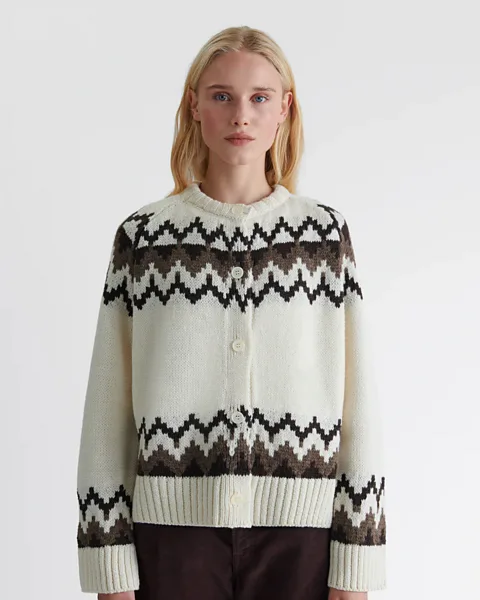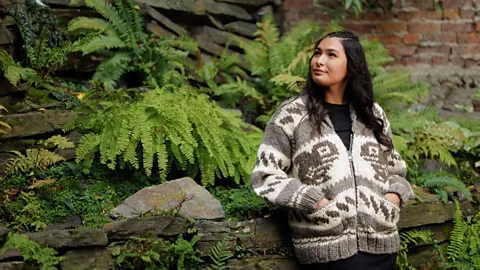How one great sweater can last a lifetime
 Getty Images
Getty ImagesThe Dude, Taylor Swift and Harry Styles all have their favourites. But what is the perfect jumper – Celtic classic, Cowichan knit or "extreme cashmere"?
In the new Netflix comedy Good Grief, Emma Corrin knits a jumper in a London gallery while art patrons stare, transfixed. The whole scene takes less than five minutes, but fans have already turned the moment into a viral trend, with fervent comments in all caps, such as "EMMA CORRIN, I WILL HOLD YOUR YARN DRESS WHILE YOU SCREAM ANY DAY OF THE WEEK!" The enthusiasm for the comedy cameo makes sense, since Corrin is gorgeous, cool, and a fantastic actor. But as fashion weeks commence, the knitwear scene also fits nicely into a moment that puts jumpers at the centre of pop culture glory.
More like this:
No longer a basic granny staple, classic knitwear has gone big thanks to scene-stealing sweaters on Chris Evans in Knives Out and Harry Styles on stage. Taylor Swift named a song on the album Folklore after the humble cardigan, and Miuccia Prada embraced the lowly crewneck as a high fashion staple in her last few collections. Emerging British designer Molly Goddard elevated the Fair Isle, too, when she piled it on top of a tulle party dress for maximum whimsy – a look that street style starlets and fast fashion chains worldwide have copied.
 Getty Images
Getty ImagesAs wool's popularity spikes in fashion spaces, so do questions about the ethics and effects of a jumper on the land and its inhabitants. Is a wool sweater an environmental win, or another way we're hurting the planet? The answer, like the jumpers themselves, is a little fuzzy.
"What people don't know about a good sweater," says Saskia Dijkstra, "is that it's one of the few items of clothing that directly connects you to the Earth and to very old traditions" of farming and knitting. Dijkstra is the founder of Extreme Cashmere, a knitwear brand based in Amsterdam that makes small-batch collections of sweaters from a tiny supply chain. They source their wool from family-run farms in Inner Mongolia, close to Dijkstra's Hong Kong home base, where she spent 25 years creating sweaters for high-end labels like Joseph and Agnès b, along with Banana Republic. "But I wanted to make sweaters without any concessions," she explains. "I wanted the best wool, the most responsible sourcing, the most inclusive design… I wanted to make sweaters with a [supply] chain you could trace back to the very beginning, and that you would have, and wear, for life. That's what a sweater is meant to be," she says. "A companion."
Knitting – the process of knotting threads together with needles to create an intricate textile – is a global technique with ancient origins worldwide. Archaeologists have found knitted cotton socks from the 11th Century in Cairo, though an older process called Nålbinding ("needle binding" in Norwegian) has been recorded in Scandinavia, the Middle East and Germany, according to the Victoria & Albert Museum.
 &Daughter
&DaughterKnitwear was a staple for fishermen and other outdoor workers in the 1700s, but it wasn't until the late 1800s that jumpers became a fashion statement, propelled by a new interest in sports like cricket, tennis, golf, and cycling. At the same time, communities of Indigenous craftswomen in North America began fusing their own traditional designs with newer silhouettes and machine-made yarn, inventing famous new fashion staples like the Cowichan sweaters of Vancouver Island. These handcrafted, chunky cardigans became an iconic look in popular culture from the 1960s, worn by the likes of Steve McQueen, Marilyn Monroe, TV cop Starsky and film legend Jeffrey "The Dude" Lebowski. In 2023, an online boutique called Knit Wutth'els opened to directly connect First Nations designers in Canada with shoppers, including pieces created by Coast Salish community artists like Zena Rowland, whose name appears on the label.
Cultural threads are also passed down at &Daughter, the buzzy British start-up by Buffy Reid, who serves as the creative director and co-founder. Now sold at Net-a-Porter and Matches, &Daughter began as a connection to Reid's Irish heritage. "My granny was an amazing knitter, and she passed that knowledge and passion on to my father," she explains. "He made his life's work the Irish and Scottish knitwear of the highest quality… I always loved the stories involved in their making, the spinning of the yarn, the handcraft involved. Each stitch tells a story, maybe more so than any other piece of clothing." By wearing it, Reid says, you're supporting local communities and sharing their way of life with the world.
Less is more
Handmade jumpers can also carry environmental benefits, especially when the knitters know where and how their wool is procured. According to Irish-American sustainable designer Maria McManus, supporting small farms with regenerative practices "isn't just the right thing to do – it's the only thing to do". Designer wool is only considered super-premium when sheep and goats are healthy, respected and well-tended – standards that must also apply to land management and labour practices from the first shear to the final stitch.
Many flocks have been in the same families for generations, and farms like Dot Ranch in America and Dowrene Farms in Australia are helmed by Indigenous growers working with traditional farming methods.
 Victoria Native Friendship Centre
Victoria Native Friendship CentreOf course, wool may be beneficial to native land managers, but it is certainly not vegan. On the other hand, it's also not a plastic-based synthetic that can leach into our waterways and even our bloodstreams. Though factory farming of all kinds, including wool, is an unethical and cruel practice, some animal scientists and bioethicists argue that humanely shearing sheep is both possible and beneficial for both wool quality and human welfare. That includes Dr Richard Erhardt, a veterinary scientist whose work at Michigan State University finds that when done properly, shearing wool decreases a flock's exposure to disease, increases birthweight and baby weight in lambs, and even "improves maternal bonding" among ewes and their offspring. Today, some shearing techniques are certified as "cruelty-free" by the global welfare organisation Leaping Bunny, including the Nepali wool collective Friendsheep, located in Kathmandu.
But careful wool farming and regenerative practices can benefit soil health when it's done in small doses. In a land conservation handbook by the University of Idaho, ecology professors Karen Launchbaugh and Dr John Walker report that biodiversity and soil resilience increases when sheep graze agricultural land. In wild areas, sheep and goats clear brush (shrubs, bushes and small trees) that may become wildfire tinder; they also gobble invasive species more effectively than pesticides. When grazing in city parks and small towns, sheep have also been found to help decrease stress and increase feelings of happiness among humans nearby, according to an additional study from the University of California (UC) Davis. To ensure the sheep themselves are just as happy, ask questions about where your wool comes from, and if possible, tell designers you'd like to see photos and videos of their flocks, as well as the names of their farms.
Not all feelings toward modern knitwear are warm and fuzzy. In an October article for The Atlantic, the writer Amanda Mull proclaimed, "your sweaters are garbage", saying that cheap wool and poor construction had ruined knitwear for everyone, and that "even expensive sweaters have lost their hefty, lush glory". In response, social media users soon began grumbling that their cardigans and cable knits were sloppy and sad.
"I get so angry when I buy a nice sweater and it ends up getting all stretched out the first time I wear it," says Ruby Matheu, a young New York designer who has noticed a lack of wool quality in newer models, and prefers to shop second-hand for sweaters instead.
"When you get a blend of wool and synthetic cheaper yarn, that's when it gets quite bad," says McManus. "It will unravel faster and pill more, and if it gets wet, there's not a guarantee that you'll stay warm. Plus, if it ever ends up in a landfill, it will just shed plastics."
 Getty Images
Getty ImagesIf you choose to buy new wool, experts say caring for your knitwear by hand-washing it and gently "brushing" it with a fine-tooth comb can make all the difference, especially since the lifecycle of a pure wool garment should be part of its sustainable benefits. "If we can make a jumper that lasts for decades rather than mere months then we encourage a less-but-better approach to fashion which reduces our consumption levels," explains Reid. "Moreover, wool is a natural, biodegradable material… if a jumper ever reaches the end of its use, it can return to the soil and naturally decompose." For jumpers using recycled or repurposed wool, the effects can be even greater, saving up to 75% of production energy, according to a 2022 study from scientists at the University of Leeds.
Dijkstra hopes that smaller labels like hers can change that perception through higher quality and environmental standards, along with the cool factor that comes from spotting Extreme Cashmere on fashion editors and NBA players in the wild. "You'll know it's the right sweater for you, because when you put it on, everything will feel a little better," she says. "I love sweaters because, in a quiet way, they really can be magic." And when you find the right one, who knows, it might just last a lifetime.
The Changing Room is a new column from BBC Culture that spotlights the fashion innovators on the frontlines of a style and sustainability evolution.
If you liked this story, sign up for The Essential List newsletter – a handpicked selection of features, videos and can't-miss news delivered to your inbox every Friday.
